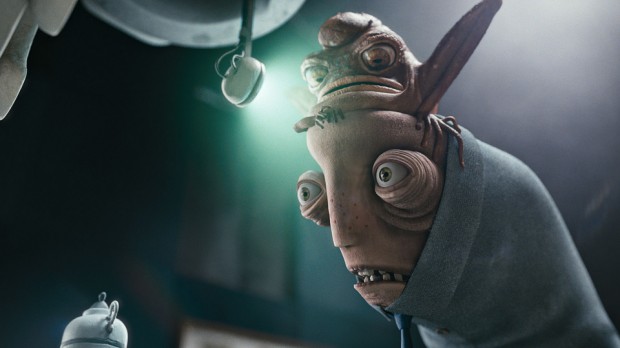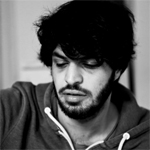Director Kariem Saleh’s inventive and poignant CG-animated short Song of a Toad was picked as the 2017 SIGGRAPH festival’s Best of Show. The talented animator and vfx artist, who is currently working at Berlin’s RISE Visual Effects Studios, is in Los Angeles this week to attend the festival. He was kind enough to talk to us about his stand-out short, which is now qualified for Oscar consideration, and innovative animation methods:
Animation Magazine: First of all, a big congratulations on the success of your fantastic short. Can you tell us a little bit about how you came up with the concept while you were a student at Filmakademie Baden-Wurttemberg, and the new methods you used to create the animation?
Kariem Saleh: I began the short when I was in school in 2014. The project took us about three years to complete. The short, which is produced by Alexandra Stautmeister, was inspired by the interesting illustrations of children’s books artist Jelena Walf. We wanted to develop a style that worked well with her 2D designs. The topic I had in mind was how our upbringing influences our adult life, which is a complex subject. It took us about a half a year to boil it down to a simple concept of someone visiting a psychiatrist with a toad on his head. I guess the message of the short is that silencing your inner child doesn’t make you a happy adult in the end.
Can you tell us a little bit about the process and the tools you used to bring the story to CG life?
Saleh: Sure, we developed several tools for the short. One thing we did was to build our miniature sets. We handcrafted them and used a process called photogrammetry to digitize those sets and put them in a 3D environment, then render them in Arnold. We really wanted to have a way of capturing the hand puppetry and the movements of the hand in a more intuitive and direct way. So we built a mechanical rig and used an Arduino Micro controller computer chip to analyze the data that comes out of the sensor. We were able to get the date from the sensor to our character rigs. We did the first pass of the animation, then produced many takes of the scene, and then edited them together to have the rough version of the film to animate. Then we added a Maya rig on top of the capture rig to offset the animation.
What would you say was the project’s biggest challenge for you and your team?
Saleh: To be honest, the biggest challenge was just getting it all done. Because of all the new experiments we did, we had about 50 people working on it at different times, doing various things, from modeling, texturing the assets, some were rigging, etc. We were all students, so it was hard to get people to commit for long periods of time. People were coming on and off the project, so it was hard to keep track of everything. But I was lucky because everyone was very helpful and committed to our project. I was also fortunate because after I graduated, I found a job that allowed me to continue working on the project on my time off. Our pipeline TD Vincent Ullmann was my bridge to the school and we were able to use the render farm there.
Why did you decide to develop your own tools for the animation?
Saleh: I think the art really demanded a completely different approach to animation. We still used traditional animation rigging in Maya, but for the starting point of the animation, I wanted to have something that gave us more direct and intuitive control. The goal was to translate what we had on our mind to the machines with an easy way without scribbling everything out and blocking all the poses. We didn’t block out the animation in a traditional way. We used motion-capture technology, but not with a suit. I just wanted to use the hands and fingers, via puppetry. Of course, we weren’t the first ones to do this. The Henson Company has been producing TV series using their own proprietary technology for many years. Ours was more of a prototype using glove puppetry. I would love to continue exploring the technology, combining them with Virtual Reality. It is a new way of making an animated movie. Of course, you need lots of money and time to explore these new avenues.
What kind of advice would you give animation students who want to make important, innovative projects just like you and your team?
Saleh: Don’t forget to have a time limit. Some people spend seven or eight years on their films and never get them finished. Be ready to make compromises to finish your short. Stick to your vision and do what your heart tells you to do. It’s never a good idea to just do an exercise that just shows people what you can do technically. I see that a lot in schools. Stick with your own ideas of animation and filmmaking.
Who are some of your animation and filmmaking inspirations?
Saleh: Ed Catmull inspires me in an entrepreneurial ways. Of course, Walt Disney as well. I am inspired by the mindset of doing something new and pioneering that nobody has done before. Other big influences include Aki Kaurismaki, Charlie Kaufman and Spike Jonze. Even though it’s not obvious, I am really into the whole live-action thing as much as I love animation. The short film I am currently developing is full live action, set in the streets of Berlin.
What do you think of the animation and tech climate in 2017 and beyond?
Saleh: There is more animation being produced both in Germany and around the world. Innovative directors are exploring animation in many different forms—motion capture, stop motion, and also traditional animation… We are seeing tools getting more accessible for Virtual Reality and Augmented Reality as well. Germany is slowly developing its feature film animation industry and different companies are venturing out in that direction. It is an exciting time to see all these different things coming together. There are so many ways of telling stories today.
Here is a behind-the-scenes look at Song of a Toad:





 Win a Funko X Lilo & Stitch Prize Pack!
Win a Funko X Lilo & Stitch Prize Pack! 
